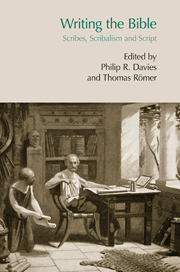Book contents
- Frontmatter
- Contents
- Abbreviations
- 1 Introduction
- I Writing in the ancient world
- II Hebrew Bible and early Judaism
- III Early Judaism and early Christianity
- 10 Some scribal features of the thematic commentaries from Qumran
- 11 Efficacious writing: the inscription of the rosette on the High Priest's forehead and the Egyptian reception of Exodus 28
- 12 The prose writer (συγγραφεύς) and the cultures of author and scribes: the examples of Galen and the anonymous author of Luke-Acts
- 13 Peter and his secretary in Pseudo-Clement
- 14 On the danger of writing according to Origen
- Index of biblical and other ancient sources
- Author index
12 - The prose writer (συγγραφεύς) and the cultures of author and scribes: the examples of Galen and the anonymous author of Luke-Acts
- Frontmatter
- Contents
- Abbreviations
- 1 Introduction
- I Writing in the ancient world
- II Hebrew Bible and early Judaism
- III Early Judaism and early Christianity
- 10 Some scribal features of the thematic commentaries from Qumran
- 11 Efficacious writing: the inscription of the rosette on the High Priest's forehead and the Egyptian reception of Exodus 28
- 12 The prose writer (συγγραφεύς) and the cultures of author and scribes: the examples of Galen and the anonymous author of Luke-Acts
- 13 Peter and his secretary in Pseudo-Clement
- 14 On the danger of writing according to Origen
- Index of biblical and other ancient sources
- Author index
Summary
INTRODUCTION
The present volume is the result of a colloquium that was entitled Writing and Scribalism in English, and Comment écrit-on in French. In the English title, the accent is on the process and conditions of the transmission of the writing, going beyond a consideration of the auctor. The French title Comment écrit-on includes both those who produced and also those who transmitted writings, the authors and the scribes or copyists, in Antiquity.
The “comment”—the “how”—can be understood entirely in a material sense, covering topics ranging from the stylus to the codex or, alternatively, in the sense of the conditions in which the writing was transmitted, notably the political dimension of this transmission. However, the question “comment on écrit” can also refer to the person who wrote the text, the author, and to his or her editorial and literary procedures, or even to their “literary posture”. The overlap of authors and scribes/copyists implied in the French title lends itself to a consideration of the relation between the culture of the author and that of the scribe(s). The medievalist Jean-Claude Mühlethaler (2008: 437) drew attention to this “scribal culture’, which often prevailed over the authorial culture until as late as the fifteenth century. The authorial culture/scribal culture interface is a particularly appropriate topic for anyone working in the fields of the New Testament and the Hellenistic culture of the first centuries of the common era, and that for three principal reasons will be elaborated in this chapter.
- Type
- Chapter
- Information
- Writing the BibleScribes, Scribalism and Script, pp. 159 - 176Publisher: Acumen PublishingPrint publication year: 2013

